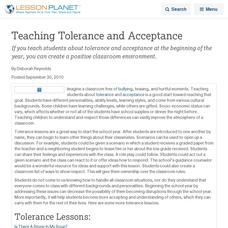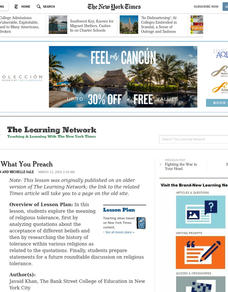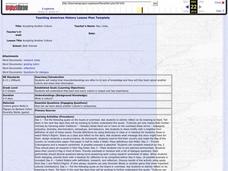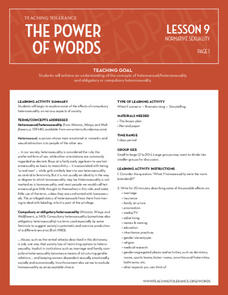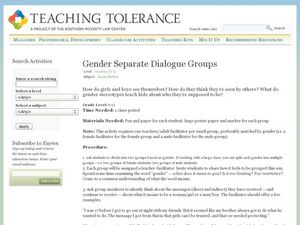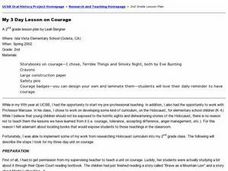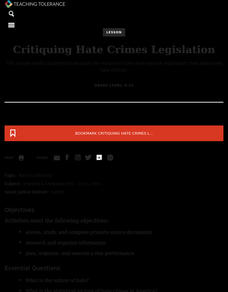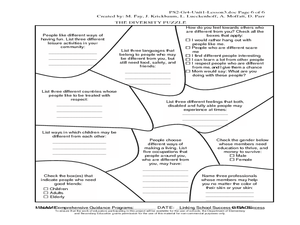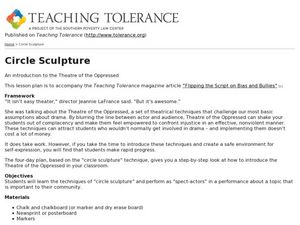Curated OER
Teaching Tolerance and Acceptance
If you teach students about tolerance and acceptance at the beginning of the year, you can create a positive classroom environment.
Curated OER
The Crayon Box that Talked: Welcoming Indviduality
Just like a box of crayons, every child has a special way of contributing to the greater picture.
Curated OER
Exploring Tolerance and Related Essential Questioning on Acceptance and Diversity
Students explore the concept of diversity. They discuss ways in which people differ. Students visit various websites and discuss the vocabulary words found on these sites. They read stories from various countries and discuss the people...
Curated OER
No Name Calling
Students use literacy skills to gain information about tolerance. In these lessons on acceptance, student read stories, answer questions, survey students, and plan a citizenship week to encourage participation in a No Name Calling week.
Curated OER
Practice What You Preach
Students explore the meaning of religious tolerance, first by analyzing quotations about the acceptance of different beliefs and then by researching the history of tolerance within various religions as related to the quotations.
Curated OER
Character Education - Tolerance "The Big Orange Splot"
Students explore the character trait of tolerance. They listen to the story, The Big Orange Splot, discuss the concept of tolerance, and create a house out of a cereal box and other craft materials.
Curated OER
Accepting Another Culture
Students explore cultural diversity. In this cultural acceptance lesson plan, students read Molly's Pilgrim and examine the message of the story. Students research other cultures and create culture-grams and complete research...
Curated OER
Cultural Spaces
As a way to help your students understand tolerance, personal space, and cultural diversity, this lesson has them give up personal space for three minutes. There is no discussion prior to this activity and seemingly very little after....
Curated OER
What Shape is That?
Each country or group of people has created special places of worship. Children read a story about religious buildings and architecture and then make clay models of the buildings they like the best. The lesson has been written to...
Curated OER
Test Yourself for Hidden Bias
Students examine their own hidden bias. For this diversity lesson, students link to an Internet website to test their own stereotypes and prejudices. Students discuss how bias is perpetuated in society and determine what they can to...
Teaching Tolerance
The Power of Words: Normative Sexuality
Students collect newspaper articles which discuss societies who enforce heterosexuality. They brainstorm how heterosexuality is enforced in their community. They answer questions to end the instructional activity.
Curated OER
Exploring Cultural Rituals
Students analyze images and music of common rituals in America with those of other countries. They use worksheets to compare and contrast the events.
Curated OER
Gender Separate Dialogue Groups
Students complete studies to learn about tolerance for gender groups. In this gender study lesson, students are divided into gender groups and discuss how it feels to be grouped that way. Students brainstorm messages about what it means...
Curated OER
It Can't Happen Here or Can It?: Peer Pressure, Prejudice and Intolerance
Students examine the pressures of group-pressured behavior. In this teaching tolerance lesson plan, students read literature and view videos regarding negative group behavior. Students answer comprehension questions and participate in a...
Curated OER
Confronting the -Isms
Learners keep "Mindwatch" diaries to chart their own prejudices and stereotypes. For this social justice lesson, students monitor their own reactions to people who are different from themselves. Learners identify and discuss patterns of...
Curated OER
Perceptions - Difference
Students explore different perceptions and differences between people. They incorporate the themes of stereotypes, prejudice and discrimination. Students comprehend that people have different perceptions of the same phenomenon. They...
Curated OER
My 3 Day Lesson on Courage
Second graders focus on what having courage means. They listen to a story about the Holocaust, then create posters which reflect courage, tolerance and acceptance.
Curated OER
Good Apples
Students choose an apple from a larger group of apples and examine it closely. They return their apples to the group and then attempt to identify their own. They discuss how this activity applies to human similarities and differences.
Teaching Tolerance
Critiquing Hate Crimes Legislation
The high school lesson explores what hate crimes are and how the government has responded to those crimes. Academics read legislation, analyze political cartoons, and complete hands-on-activities to understand what motivates individuals...
Curated OER
Colors and Trouble
Pupils discuss what it would be like if there weren't enough resources by reading " The Land of Many Colors." In this tolerance instructional activity, students identify the differences between tolerant and intolerant behavior. Student...
Curated OER
Respect for All Kinds of People Inside and Outside the School
Fourth graders explore the concept of respect. In this diversity lesson, 4th graders play the Untangle Game and complete a diversity puzzle. Students consider how to emphasize similarities over differences.
Curated OER
Visualizing School Equity
Young scholars examine the funding gap in school systems. In this diversity education lesson, students read an article regarding the inequitable school funding. Young scholars research information pertaining to school funding in their...
Curated OER
Circle Sculpture
Students discover the Theatre of the Oppressed. In this diversity lesson, students practice confronting injustice as they participate in "circle sculpture" to role play performance models that deal with social justice issues. Students...
Curated OER
Speaking Kindness in Democratic Classrooms
Students write rules for their classroom. In this community building lesson, students discuss reasons for rules and write their own guidelines for appropriate classroom behavior.
